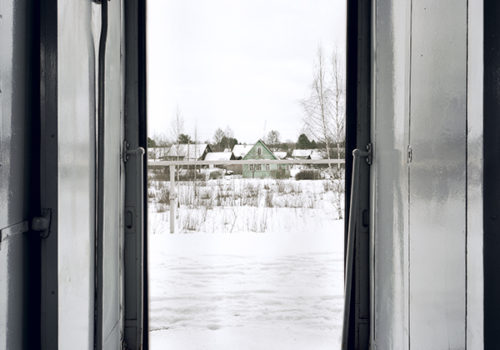Marie Bovo is exhibiting a series of snapshots taken during her travels across Central Europe and Russia, at the very moment when the train doors open: a promise of a salvo from the soul that, like an invigorating breath of fresh air, hits the eye of the standing passenger.
Some photographers supplement the natural frame of their camera with another. Marie Bovo has made it her specialty. In her work, the sensible point that catches one’s eye is always hidden behind an initial veil, a sort of immediate partition that signals the position of the photographer and forms something like the walls of a hut or a cloister.
As we board the Trans-Siberian Railway, we find ourselves at the edge of a step. The door is open and the blizzard hits one’s nose and whirls in a white fury of fresh snowflakes. Everything we see around us points to an ordinary, perhaps slightly rundown train, with its red doors, its alarm signals, its black banisters held by so many hands at the entrance to the station, waiting to begin a voyage that might either change people’s lives or propel them further along their path, or yet lead them astray.
The train is a sort of place where stories travel and intersect, interweave, and teleport. It is a space of encounter or solitude along a shared route. As the title of a Patrice Chéreau film says, Those Who Love Me Can Take the Train. In Russia one is certainly allowed to imagine Anna Karenina walking up and down the corridors of these venerable machines that nevertheless bear the signs of the communist or post-communist era. All the dream material is right there, in the transport, in the thrust, in the machine that blares and rolls forward like a flower-covered tank.
Camera prodigiosa
For Marie Bovo, the photographic act means capturing the eternity that is just outside the train window—trees, climate, earth—and at the heart of the colorful past of an abstract mechanical surface (the trains of Central Europe or Russia), where the “Red Man,” homo sovieticus, is also the snowman, the tundra dweller, the man of the great Siberian forests punctuated by tiny wooden huts where fire is lit at winter to chase away the cold.
Perhaps Marie Bovo is after that sort of euphoria that bursts forth when the train suddenly comes to a stop with the buoyant rhythm of the coupling rods and the grinding of the wheels against the rails, when we are sheltered even while observing the harsh climate and the poverty of the inhabitants. “Whenever the train stops, not knowing onto what sort of landscape, what sort of architecture, what sort of light the door will open, I install my view camera on the narrow platform at the entrance to the car. Before the door closes, like the camera shutter, the place has been imprinted on film.”
And there emerges this prodigious chamber where the traveler stands with one foot out, the other foot in. Which way is he heading? Getting off? Staying on board? Who knows… Marie Bovo possesses a bird’s curiosity: it alights and takes off before the door shuts. Perhaps her pictures are an hymn to this kind of freedom?
Jean-Baptiste Gauvin
Jean-Baptiste Gauvin is a journalist, writer, and stage director. He lives and works in Paris.
Marie Bovo, Stances
Festival des Rencontres de la Photographie d’Arles 2017
July 3 to September 24, 2017
Arles, France
















